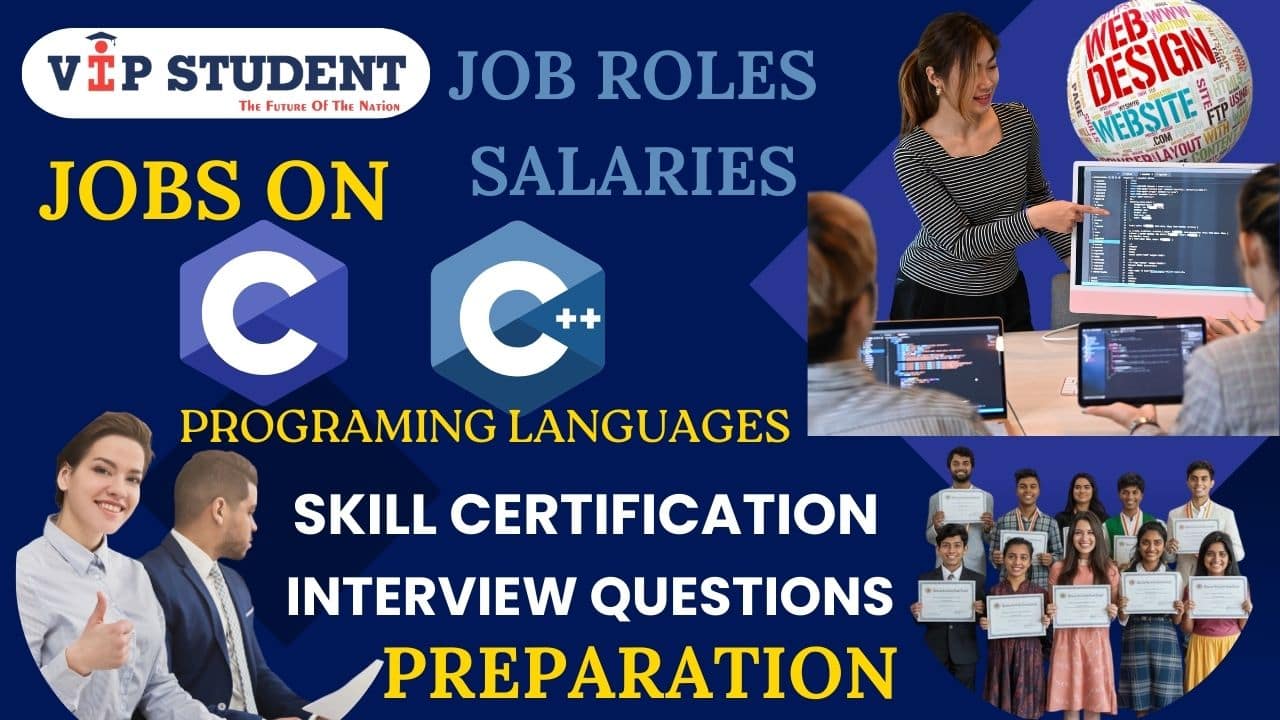LET’S KNOW ABOUT C, C++ JOB ROLES, REQUIRED SKILLS, SALARY PARTICULARS, PRACTICE JOB INTERVIEW QUESTIONS AND GET CERTIFIED ON C, C++ PROGRAMING LANGUAGE SKILLS
JOBS ON C AND C++ PROGRAMING LANGUAGE SKILLS: C and C++ are foundational programming languages that continue to power major software systems, embedded devices, and performance-critical applications. Known for their speed, control over hardware, and widespread use in system programming, these languages offer stable and rewarding career paths, especially in industries like embedded systems, gaming, telecommunications, and operating system development. Whether you’re a job seeker or a student planning your career, let’s know about C, C++ job roles, required skills, practice on job interview questions and get certified on your C, C++programing language skills.
C and C++ Job Roles And Career Opportunities
Professionals with expertise in C and C++ can explore a range of job roles, including:
1. Software Developer/Engineer (C/C++)
- Develop desktop or system-level software.
- Work on applications requiring high performance and low-level memory manipulation.
2. Embedded Systems Developer
- Program microcontrollers and firmware using C/C++.
- Common in automotive, healthcare devices, and consumer electronics.
3. Game Developer
- Use C++ with gaming engines (like Unreal Engine).
- Focus on real-time rendering, physics, and AI for games.
4. System Programmer
- Work on OS kernels, device drivers, and system utilities.
- Often involves writing highly optimized and efficient code in C.
5. Compiler Engineer
- Develop and maintain compilers, interpreters, and static analysis tools.
- Deep knowledge of language internals is required.
6. Application Developer
- Create cross-platform applications.
- Use C++ with GUI libraries like Qt or wxWidgets.
7. Networking Software Engineer
- Work on protocols, routing, and communication stacks.
- C is often used for writing low-latency network applications.
8. Firmware Developer
- Program hardware interfaces in industries like robotics or IoT.
- Mostly written in C due to its efficiency and close-to-metal control.
Required Skills for C and C++ Jobs
To secure roles in C/C++ domains, professionals should possess both technical and soft skills:
Core Technical Skills
- Proficiency in C and C++ syntax, concepts, and standard libraries.
- Understanding of Object-Oriented Programming (OOP) in C++.
- Experience with pointers, memory management, and dynamic allocation.
- Familiarity with data structures and algorithms.
- Knowledge of multi-threading, concurrency, and synchronization.
- Proficiency in debugging tools like GDB or Valgrind.
- Hands-on with version control systems (e.g., Git).
- Experience with CMake, Makefiles, or other build tools.
- Familiarity with operating systems concepts, especially for system-level roles.
Optional/Advanced Skills
- Exposure to STL (Standard Template Library) in C++.
- Understanding of embedded system design and RTOS.
- GUI development with libraries like Qt, GTK, or wxWidgets.
- Cross-platform development experience (Windows/Linux).
- Working knowledge of scripting languages like Python or Bash (for automation).
Soft Skills
- Problem-solving and analytical thinking.
- Strong communication and documentation skills.
- Ability to work in agile teams and handle collaborative projects.
- Attention to detail and code quality.
Career Opportunities in C and C++
C and C++ open doors to various industries and domains:
1. Embedded Systems
- Companies like Bosch, Siemens, and Qualcomm hire C developers for firmware.
- Roles include automotive systems, medical devices, and consumer electronics.
2. Gaming Industry
- C++ is the core language behind major game engines.
- Developers work on game logic, rendering engines, and simulation systems.
3. Operating System and System-Level Programming
- Organizations like Microsoft, IBM, and Red Hat require system programmers.
- Tasks include writing drivers, kernel modules, and performance-critical utilities.
4. Finance and High-Frequency Trading (HFT)
- Use C++ for ultra-low latency and high-performance systems.
- Companies include Morgan Stanley, Bloomberg, and Citadel.
5. Telecom and Networking
- Develop switches, routers, and communication protocols.
- Companies like Cisco, Nokia, and Ericsson hire for such roles.
6. Aerospace and Defense
- Safety-critical systems in avionics and defense require C/C++ developers.
- Knowledge of MISRA standards (for safety) is beneficial.
7. Compilers and Toolchain Development
- Work on GCC, LLVM, or custom compilers and linkers.
- Suited for professionals interested in language theory and optimization.
8. Cross-platform Desktop Application Development
- Build GUIs and tools using C++ and Qt or similar frameworks.
- Used by software tools companies and automation system developers.
🧾 C and C++ Job Roles – India vs Global Salary Comparison
| Job Role | Experience Level | India Salary (INR/year) | Global Salary (USD/year) |
|---|---|---|---|
| 1. Software Developer (C/C++) | 0–2 years | ₹3.5 – ₹6.5 LPA | $75,000 – $95,000 |
| 3–5 years | ₹6 – ₹12 LPA | $95,000 – $120,000 | |
| 6–10 years | ₹12 – ₹22 LPA | $120,000 – $150,000 | |
| 2. Embedded Systems Developer | 0–2 years | ₹3 – ₹6 LPA | $70,000 – $90,000 |
| 3–6 years | ₹6 – ₹13 LPA | $90,000 – $115,000 | |
| 7–10 years | ₹12 – ₹20 LPA | $115,000 – $130,000 | |
| 3. Game Developer (C++) | 0–2 years | ₹4 – ₹7 LPA | $80,000 – $100,000 |
| 3–5 years | ₹7 – ₹15 LPA | $100,000 – $125,000 | |
| 6–10 years | ₹15 – ₹25 LPA | $125,000 – $140,000 | |
| 4. System Programmer | 1–3 years | ₹5 – ₹8 LPA | $90,000 – $110,000 |
| 4–6 years | ₹8 – ₹16 LPA | $110,000 – $135,000 | |
| 7–12 years | ₹16 – ₹30 LPA | $135,000 – $160,000 | |
| 5. Compiler Engineer | 1–3 years | ₹6 – ₹10 LPA | $100,000 – $130,000 |
| 4–8 years | ₹10 – ₹20 LPA | $130,000 – $160,000 | |
| 8–15 years | ₹20 – ₹40+ LPA | $160,000 – $180,000+ | |
| 6. Application Developer (C++) | 0–2 years | ₹3.5 – ₹7 LPA | $75,000 – $95,000 |
| 3–6 years | ₹7 – ₹13 LPA | $95,000 – $115,000 | |
| 6–10 years | ₹13 – ₹22 LPA | $115,000 – $135,000 | |
| 7. Networking Software Engineer | 2–5 years | ₹7 – ₹15 LPA | $100,000 – $125,000 |
| 6–10 years | ₹15 – ₹28 LPA | $125,000 – $160,000 | |
| 10+ years | ₹30 – ₹50+ LPA | $160,000 – $180,000+ | |
| 8. Firmware Developer | 1–3 years | ₹3.5 – ₹7.5 LPA | $80,000 – $100,000 |
| 4–6 years | ₹7.5 – ₹14 LPA | $100,000 – $120,000 | |
| 7–12 years | ₹14 – ₹25 LPA | $120,000 – $135,000 |
💡 LPA = Lakhs Per Annum
Top Companies Hiring C/C++ Professionals
- India: TCS, Infosys, HCL, Wipro, Bosch, Tata Elxsi, Qualcomm, L&T Technology Services.
- Global: Microsoft, Intel, Apple, Nvidia, Google, IBM, Oracle, Cisco, Bloomberg, Ubisoft.
Certifications and Learning Resources
While not mandatory, certifications can add value:
- C Programming Language Certification – offered by edX, Udemy, Coursera.
- C++ Institute Certifications:
- CPA – C++ Certified Associate Programmer
- CPP – C++ Certified Professional Programmer
- Embedded Systems Certification – NPTEL, Coursera, or Texas Instruments Academy.
Recommended Learning Platforms:
- GeeksforGeeks, HackerRank, LeetCode (for practice)
- Udemy, Pluralsight, Coursera (for in-depth courses)
- GitHub (for open-source projects and collaboration)
✅ General Interview Questions on C Programing Language Jobs
1. What is C language?
C is a high-level, structured programming language developed for system software and application development. It supports low-level memory access and procedural programming.
2. What are the key features of C?
Portability, low-level memory manipulation, simple syntax, speed, modularity, and use of pointers.
3. What are the different data types in C?
Basic types: int, float, double, char; Derived types: arrays, structures, pointers, unions.
4. What is the difference between int and float?
int stores whole numbers; float stores decimal numbers.
5. What is a pointer in C?
A pointer is a variable that stores the address of another variable.
6. What is a NULL pointer?
A pointer that doesn’t point to any memory location; it’s usually initialized as NULL.
7. What is the use of sizeof operator?
It returns the size (in bytes) of a variable or data type.
8. What is the difference between = and == in C?
= is the assignment operator; == is the equality comparison operator.
9. What is recursion?
When a function calls itself directly or indirectly.
10. What is the purpose of main() function?
It is the entry point of every C program. Program execution starts from here.
11. What is a structure in C?
A structure is a user-defined data type that allows grouping of variables of different types.
12. What is the difference between struct and union?
In struct, each member has its own memory. In union, all members share the same memory.
13. What is a static variable?
A variable that retains its value between function calls and has a scope limited to the file or function.
14. What are storage classes in C?
auto, register, static, and extern define scope, lifetime, and visibility of variables.
15. What is a global variable?
A variable declared outside any function, accessible throughout the program.
16. What is a local variable?
A variable declared inside a function, accessible only within that function.
17. What is the difference between call by value and call by reference?
Call by value passes a copy; call by reference passes the address.
18. What is the use of const keyword?
It makes variables read-only; their values cannot be modified after initialization.
19. What is a function in C?
A reusable block of code that performs a specific task.
20. What are header files?
They contain declarations of functions and macros. Example: #include <stdio.h>.
21. What is the difference between getchar() and getch()?
getchar() echoes input and is standard; getch() is non-standard and does not echo input.
22. What is the use of printf() and scanf()?
printf() outputs data; scanf() reads input from the user.
23. What is a segmentation fault?
An error caused by accessing unauthorized memory (e.g., dereferencing an invalid pointer).
24. What is an array in C?
A collection of elements of the same type stored in contiguous memory locations.
25. What is a multidimensional array?
An array of arrays, like a matrix: int arr[3][3];
✅ Practical Interview Questions on C Programing Language jobs
26. Write a C program to reverse a string without using a library function.
Use a loop and swap characters from both ends.
27. Write a function to check if a number is prime.
Check divisibility from 2 to sqrt(n).
28. Write a program to swap two numbers without using a third variable.
Use arithmetic: a = a + b; b = a - b; a = a - b;
29. Write a C program to count the number of vowels in a string.
Use a loop and condition to check for vowels.
30. Write a program to find the factorial of a number using recursion.
Use if (n <= 1) return 1; else return n * factorial(n - 1);
31. Write a program to check if a string is a palindrome.
Compare characters from both ends using a loop.
32. Write a C program to sort an array using bubble sort.
Use nested loops to swap adjacent elements.
33. Write a program to find the largest element in an array.
Initialize max with first element and compare with others.
34. How do you dynamically allocate memory in C?
Using malloc(), calloc(), realloc(), and free().
35. What is the difference between malloc() and calloc()?
malloc() allocates uninitialized memory; calloc() initializes memory to zero.
36. Write a C program to merge two arrays.
Use loops to copy elements of both arrays into a third array.
37. Write a program to find the second largest number in an array.
Track two variables: first and second during iteration.
38. Write a program to count the frequency of elements in an array.
Use a loop and a frequency array or hash map.
39. Write a program to reverse a number.
Use while(n > 0) { rev = rev * 10 + n % 10; n /= 10; }
40. Write a program to convert a decimal number to binary.
Use division by 2 and store remainders in reverse order.
41. Write a program to check if a number is even or odd.
Use if (n % 2 == 0).
42. Write a C program to find the GCD of two numbers.
Use Euclidean algorithm with recursion or loop.
43. Write a program to print the Fibonacci series.
Use a loop or recursion to print up to n terms.
44. Write a program to implement a simple calculator using switch case.
Read operator and operands, use switch(op).
45. Write a program to copy a string manually.
Use a loop to copy characters until '\0'.
46. Write a program to count words in a sentence.
Increment counter when a space is followed by a character.
47. Write a program to remove duplicates from an array.
Use nested loops or hashing to skip duplicates.
48. How do you pass an array to a function in C?
Pass the base address and size as arguments: func(arr, size);
49. Write a C function to find the length of a string without using strlen().
Loop through characters until '\0' and increment counter.
50. What is the use of volatile keyword?
Tells the compiler not to optimize the variable, as it can be changed unexpectedly (e.g., hardware).
✅ General Interview Questions and Answers On C++ Programing Language jobs
1. What is C++?
C++ is a general-purpose, object-oriented programming language derived from C, supporting classes, inheritance, polymorphism, encapsulation, and abstraction.
2. What are the key features of C++?
Key features include OOP support, function overloading, templates, exception handling, STL (Standard Template Library), and low-level memory manipulation.
3. What is the difference between C and C++?
C is procedural, while C++ supports both procedural and object-oriented programming. C++ includes features like classes, inheritance, and templates.
4. What is a class in C++?
A class is a user-defined data type that contains data members (variables) and member functions (methods).
5. What is an object in C++?
An object is an instance of a class that holds actual values and can use the class’s methods.
6. What is inheritance in C++?
Inheritance allows a class to inherit properties and behaviors (members) from another class, promoting code reuse.
7. What are the types of inheritance in C++?
Single, Multiple, Multilevel, Hierarchical, and Hybrid inheritance.
8. What is polymorphism?
Polymorphism means “many forms” and allows functions or operators to behave differently based on context (compile-time and run-time polymorphism).
9. What is function overloading?
Function overloading allows multiple functions with the same name but different parameter types or counts.
10. What is operator overloading?
It allows you to redefine the way operators work for user-defined types (e.g., + for adding objects).
11. What is the difference between compile-time and run-time polymorphism?
Compile-time: achieved via function/operator overloading. Run-time: achieved via virtual functions and inheritance.
12. What are access specifiers in C++?
public, private, and protected – they define the access level of class members.
13. What is a constructor?
A constructor is a special class function that initializes objects automatically when created.
14. What is a destructor?
A destructor is a class function that is called automatically when an object goes out of scope to clean up resources.
15. What is the difference between constructor and destructor?
Constructor initializes; destructor cleans up. Constructors can be overloaded; destructors cannot.
16. What is the use of this pointer in C++?
It refers to the current instance of the class and is used to access members within the class.
17. What are virtual functions?
Virtual functions enable run-time polymorphism and are used in base classes to allow overriding in derived classes.
18. What is pure virtual function?
A virtual function declared with = 0 in a base class, making the class abstract.
19. What is an abstract class?
A class that contains at least one pure virtual function and cannot be instantiated.
20. What is the difference between an interface and abstract class in C++?
C++ does not have interfaces explicitly like Java, but abstract classes serve a similar purpose by using pure virtual functions.
21. What is encapsulation?
It’s the concept of wrapping data and methods that operate on the data within one unit (class).
22. What is data hiding?
It restricts direct access to some of an object’s components using access specifiers.
23. What is the difference between struct and class in C++?
In structs, members are public by default; in classes, they are private by default.
24. What is a friend function?
A function that is not a class member but has access to its private and protected members.
25. What are templates in C++?
Templates support generic programming by allowing functions and classes to operate with generic types.
26. What is the STL (Standard Template Library)?
STL is a collection of template classes including containers, algorithms, iterators, and function objects.
27. Name some STL containers.
vector, list, deque, map, set, unordered_map, stack, queue.
28. What is the difference between map and unordered_map?
map is ordered (uses Red-Black tree), while unordered_map is faster and unordered (uses hash table).
29. What is exception handling in C++?
It is the process of handling errors using try, catch, and throw blocks.
30. What is the use of new and delete operators?
new dynamically allocates memory; delete frees the allocated memory.
31. What is a memory leak in C++?
When dynamically allocated memory is not freed, leading to inefficient memory usage.
32. What is the difference between stack and heap memory?
Stack is fast and used for static memory; heap is used for dynamic memory allocation.
33. What are smart pointers in C++?
Smart pointers (unique_ptr, shared_ptr, weak_ptr) automatically manage memory using RAII.
34. What is RAII in C++?
Resource Acquisition Is Initialization – managing resources using object lifetime.
35. What is a lambda expression in C++?
An anonymous function object used primarily in STL algorithms and functional programming.
36. What is the mutable keyword?
It allows a member of an object to be modified even if the object is const.
37. What is const_cast in C++?
It is used to add or remove const qualifier from a variable.
38. What is a virtual destructor?
It ensures proper destruction of derived class objects when deleted via base class pointers.
39. What is the use of namespaces in C++?
Namespaces avoid name conflicts in large projects by grouping logically related entities.
40. What is function overriding?
It allows a derived class to provide a specific implementation of a base class function.
✅ Interview Questions on Practical Coding/Logic C++ Programing Language
41. Write a C++ program to reverse a string using STL.
Use std::reverse(str.begin(), str.end());
42. How do you implement a stack using STL?
Use std::stack<Type> stack; and use push(), pop(), top().
43. Write a program to find the factorial of a number using recursion.
Use int factorial(int n) { return (n <= 1) ? 1 : n * factorial(n - 1); }
44. Write a C++ function to check if a number is prime.
Iterate from 2 to sqrt(n) and check if divisible.
45. Write a C++ program to count the frequency of characters in a string.
Use unordered_map<char, int> to store counts.
46. How do you sort a vector of integers in descending order?
Use std::sort(vec.begin(), vec.end(), std::greater<int>());
47. Write a program to find the second largest number in an array.
Use two variables first and second and iterate through the array once.
48. How to find duplicates in a vector of integers?
Use unordered_set to track seen elements.
49. Write a C++ program to implement a simple class for a bank account.
Include members like account number, name, balance, and methods for deposit/withdraw.
50. Write a C++ program to implement a simple calculator using switch-case.
Take two numbers and an operator, then use switch on the operator.
GET CERTIFIED ON YOUR C PROGRAMING LANGUAGE SKILLS AND KNOWLEDGE
GET CERTIFIED ON YOUR C++ PROGRAMING LANGUAGE SKILLS AND KNOWLEDGE
GENERAL JOB INTERVIEW QUESTIONS AND SAMPLE ANSWERS
1. Tell me about yourself.
General Answer:
you have to tell about your self minimum 3 to 5 minits – Tell about your personal details like your name , parents and siblings and what they do , your location and its famous for, your acadamics like your school name, college name and mention marks you are obtained in 10th class, intermediate, graduation, post graduation (as per your education) and your school or college known for, your certification cources, your projects, your achivements , your tallents, your hobbies and skills you are good at like communication, problem-solving, and teamwork.
And conclude with “I’m looking forward to contributing my skills and strengths to a great/new organization while continuing to learn new skills and to develope my strengths.”
2. What are your strengths?
General Answer:
“My strengths include being organized, reliable, and a quick learner. I’m also good at working with others and staying calm under pressure.”
3. What is your greatest weakness?
General Answer:
“Sometimes I focus too much on details because I want everything to be perfect. However, I’ve been working on managing my time better and knowing when to move on to the next task.”
4. Why do you want to work here?
General Answer:
“I’ve heard positive things about the company’s culture and growth opportunities. I’m excited about the chance to work in an environment that values learning and teamwork.”
5. Why should we hire you?
General Answer:
“I believe I can bring value through my work ethic, adaptability, and eagerness to learn. I’m confident I can quickly become a productive member of your team.”
6. Where do you see yourself in 5 years?
General Answer:
“In five years, I hope to be in a position where I’ve gained more experience, taken on new challenges, and grown professionally within the company.”
7. Describe a challenge you’ve faced and how you handled it.
General Answer:
“I faced a situation where deadlines were tight and priorities were shifting. I stayed focused, managed my time well, and communicated clearly with my team, which helped us complete the project successfully.”
8. How do you handle stress and pressure?
General Answer:
“I try to stay calm and focused by organizing my tasks and taking short breaks when needed. I also talk to teammates or supervisors if I need support.”
9. Do you prefer to work independently or in a team?
General Answer:
“I’m comfortable with both. I enjoy collaborating and learning from others, but I can also stay focused and productive when working on my own.”
10. Do you have any questions for us?
General Answer:
“Yes, I’d like to know more about the daily responsibilities of the role and what the team culture is like.”
Jobs On C And C++ Conclusion:
C and C++ are still among the most powerful and in-demand languages for performance-critical applications. With opportunities in embedded systems, gaming, system software, and finance, these languages offer a solid career foundation with good salary prospects. Building expertise in C/C++, along with hands-on projects and continual learning, can lead to long-term success in the tech industry.
We hope these C and C++ Programing Language job interview questions are helpfull to you.Preparing for a job interview can feel overwhelming, but having thoughtful answers to common questions can make a big difference. The key is to stay confident, be honest, and tailor your responses to reflect your real experiences and goals. Use the questions and sample answers above as a guide, but remember to make them your own.






